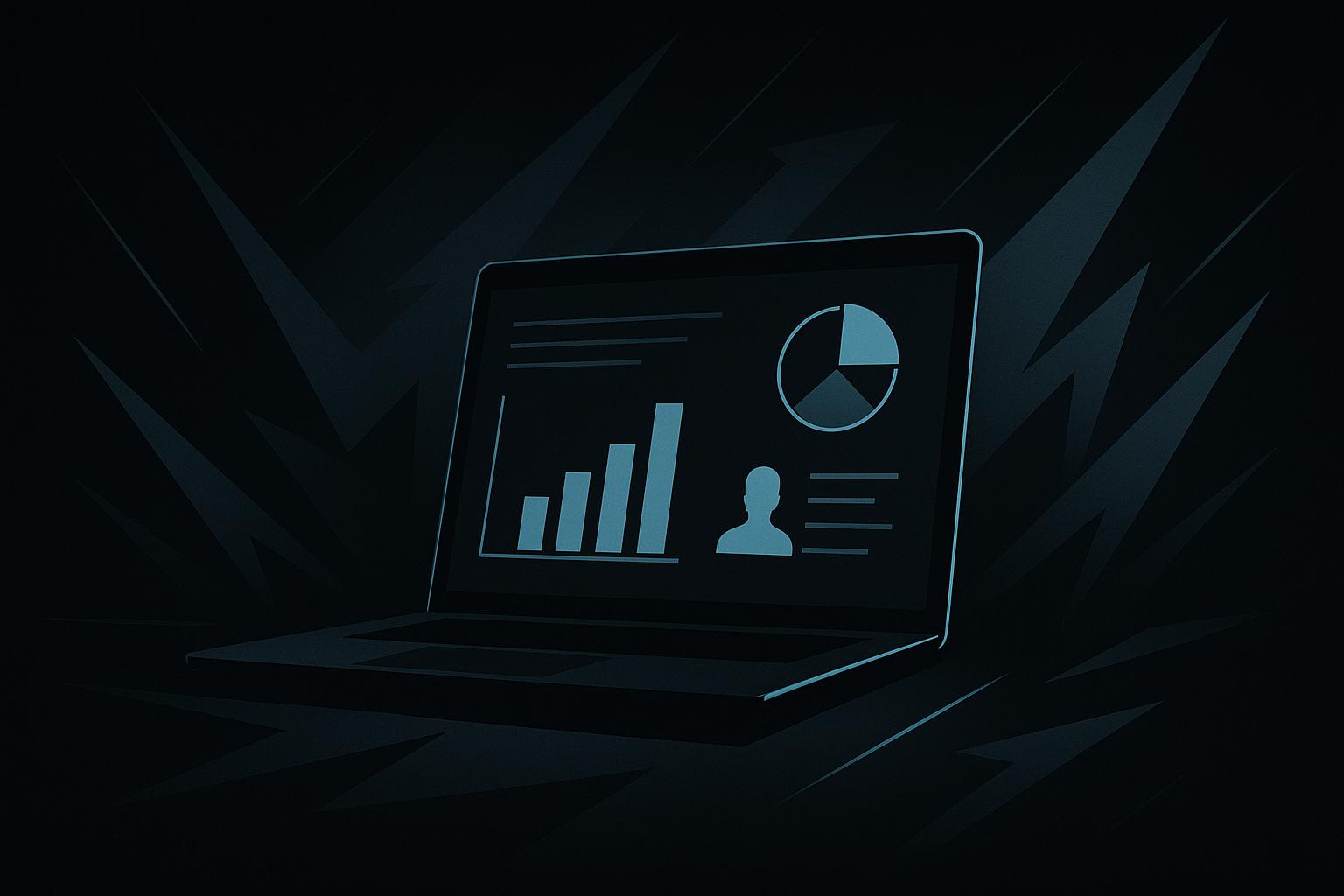Fraud costs businesses billions each year, and web scraping is becoming a key tool in detecting and preventing it. Here's how it works:
- What is Web Scraping? It’s an automated way to extract data from websites, turning messy online information into organized data for analysis.
- Why Use It for Fraud? Web scraping helps spot fake reviews, phishing sites, bot traffic, and suspicious patterns in real time.
- How It Works:
- Monitor Data: Track dark web forums, marketplaces, and websites for stolen data or fraud activity.
- Detect Patterns: Use machine learning to identify unusual behavior, like spikes in fake accounts or bot traffic.
- Real-Time Alerts: Catch fraud as it happens with live monitoring tools.
Key Applications
- Fake Reviews: Spot deceptive reviews by analyzing patterns like repetitive phrases or sudden review spikes.
- Phishing Sites: Identify malicious URLs and fake websites using web scraping and machine learning.
- Bot Detection: Flag irregular traffic or browsing behavior to block bots.
Legal Considerations
Scraping public data is generally allowed in the U.S., but accessing private or login-protected data can lead to legal issues. Always comply with privacy laws like CCPA and GDPR.
Bottom Line: Web scraping, combined with AI, helps businesses fight fraud effectively while saving time and resources.
Building an Anti-Scammer Webscraping Bot
Web Scraping Methods in Fraud Detection
Web scraping plays a critical role in fraud detection through three main approaches: extracting key data, real-time monitoring, and identifying patterns in behavior. Here's how each method contributes to uncovering and preventing fraudulent activity.
Key Data Sources
One of the first steps in using web scraping for fraud detection is identifying where cybercriminals operate. This often includes monitoring online spaces like dark web forums and cybercrime marketplaces. By gathering data from these platforms, organizations can uncover new threats.
For example, in 2021, CHAOTIC SPIDER (Desorden) sold stolen business data on platforms like RaidForums and BreachForums. Such sources provide the foundation for the real-time monitoring methods discussed next.
Live Data Monitoring
Real-time data scraping helps detect leaks as they happen, allowing for quick responses. To ensure uninterrupted monitoring, three elements are essential:
- Error handling: Keeps scraping operational, even when websites change.
- Failover strategies: Provides backup systems to avoid data gaps.
- Monitoring mechanisms: Tracks scraper performance to maintain accuracy.
Once data is collected, the next step is analyzing it for patterns that indicate fraud.
Pattern Recognition
Pattern recognition uses advanced techniques to identify unusual behaviors and trends. Here’s a breakdown of common methods:
| Technique | Application | Detection Capability |
|---|---|---|
| Clustering Analysis | Groups similar anomalies | Identifies coordinated fraud efforts |
| Time-Series Analysis | Analyzes patterns over time | Detects unusual spikes in activity |
| Feature Engineering | Develops new fraud indicators | Enhances detection precision |
Common Fraud Detection Applications
Web scraping plays a crucial role in identifying fake reviews, phishing sites, and bot traffic by leveraging pattern recognition techniques.
Fake Review Detection
Fake reviews are a growing problem for businesses and consumers alike. According to a 2023 Fakespot study, about 43% of Amazon reviews were found to be deceptive.[1]
Web scraping helps by gathering review data to identify suspicious patterns, such as:
- Generic usernames
- Sudden spikes in reviews
- Repeated phrases or overuse of specific keywords
Machine learning enhances this process by analyzing connections between buyer accounts and sellers, flagging questionable activity. For instance, in 2022, Fashion Nova faced a $4.2 million fine from the FTC for manipulating reviews, using automated tools to block low ratings and post favorable comments.
Now, let’s look at phishing site detection.
Phishing Site Identification
Phishing detection systems powered by machine learning have reached accuracy rates exceeding 97%, thanks to data collected via web scraping.[3] These systems focus on:
- URL analysis: Identifying misspellings, extra subdomains, or domains mimicking legitimate ones
- Content inspection: Spotting inconsistent branding, suspicious forms, or unexpected redirects
- Security checks: Verifying SSL certificates and evaluating domain registration details
In one study, a hybrid model combining PCA, SVM, and random forest methods achieved an impressive 96.8% accuracy rate.[4]
Next, we’ll cover how bot activity is detected.
Bot Activity Detection
Bots now account for over 40% of web traffic,[[5] making detection a priority. Web scraping tools identify bot behavior by spotting anomalies such as:
- Unusual traffic sources
- Rapid browsing patterns
- Irregular page-view sequences
- Geographic inconsistencies
Combining passive browser fingerprinting with active challenges, like CAPTCHA tests, further secures websites against bot-driven fraud.
sbb-itb-f2fbbd7
Tools and Implementation Guide
Here's how to set up and use these detection methods effectively. InstantAPI.ai makes scraper configuration and integration simple.
Pricing: $0.005 per page scrape.
- Configure the scraper: Adjust settings like geotargeting, proxy management, JavaScript rendering, and CAPTCHA bypass.
- Define data collection: Specify target URLs, create a JSON schema, and enable unlimited concurrency for efficient data gathering.
- Schedule monitoring: Automate scraping tasks to regularly check pages without manual intervention.
An example of success: Avid Power monitored over 50 marketplaces daily and reduced counterfeit sales by 30% within three months (Avid Power Internal Brand Protection Report, 2024).
"InstantAPI.ai's scraping API is fast, easy, and lets us focus on core features." – Juan, Scalista GmbH
For smooth integration into existing fraud detection systems, try our Apify connector for direct data transfer.
Advanced Detection Methods
Advanced algorithms analyze real-time data streams to uncover subtle fraud signals that might otherwise go unnoticed.
Data Pattern Analysis
By identifying statistical outliers using techniques like Z-score or IQR calculations, unusual deviations in data can be flagged. Feature engineering plays a key role here, simplifying complex data through dimensionality reduction and creating new metrics to sharpen detection accuracy.
Multi-Source Detection
Using tools like InstantAPI.ai's streaming connectors alongside Apache Kafka or Flink, you can continuously process data streams for anomalies. These systems analyze incoming information in real time, enabling quick identification of suspicious activities.
Method Comparison
Select a learning framework based on your specific data and threat environment:
- Supervised learning: Offers precision when labeled fraud patterns are available.
- Unsupervised learning: Detects new and unexpected threats without prior labeling.
- Online learning: Adjusts dynamically to evolving fraud tactics in real time.
Many systems combine these approaches for better results. For instance, machine learning models like Isolation Forest and One-Class SVM are often used together to boost detection accuracy. These adaptive models continuously refine themselves, keeping pace with new fraud trends while reducing false alarms.
Legal and Privacy Guidelines
Now that we've discussed detection methods, let's dive into the legal and privacy considerations. In 2021, the U.S. 9th Circuit Court of Appeals clarified that scraping publicly available data does not breach the Computer Fraud and Abuse Act (CFAA)[1].
U.S. Legal Framework
Web scraping activities in the U.S. are primarily governed by two key laws: the Computer Fraud and Abuse Act (CFAA) and copyright laws. While scraping public data is generally acceptable, accessing content behind login pages or in private areas can lead to potential legal issues related to unauthorized access.
- Public data: Typically allowed, but ensure compliance with robots.txt and the website's terms of use.
- Personal data: Requires consent under laws like CCPA and GDPR.
- Private/login data: High risk, as it may violate the CFAA.
- Copyrighted content: Depends on the situation; fair-use analysis is often needed.
Risk Management
To reduce legal risks, consider these steps:
- Keep crawl rates low to avoid overloading servers.
- Use clear and transparent user-agent strings.
- Secure collected data with encryption and implement strict access controls.
Privacy Standards
The California Consumer Privacy Act (CCPA) mandates that businesses inform Californians about the personal data they collect, provide opt-out and deletion options, and avoid discriminatory practices. To stay compliant:
- Categorize data based on its sensitivity.
- Limit access to sensitive data.
- Maintain detailed logs of data collection and processing activities.
Conclusion: Implementation Steps
These steps focus on using real-time scraping, pattern analysis, and legal safeguards to put fraud detection into action.
They combine earlier methods, tools, and compliance guidelines into practical steps you can follow.
Key Takeaways
Web scraping has become a valuable tool for fraud detection, enabling organizations to monitor live data streams and process large amounts of online information. Some key highlights include:
- Identifying and extracting fraud indicators in real time
- Using pattern recognition to detect anomalies
- Ensuring compliance with legal and privacy standards
Turn your detection strategy into clear, actionable steps.
Getting Started
-
Define Your Data Requirements
Outline the specific data points you need to monitor. Build a schema to map fraud indicators and structure your JSON extraction. -
Set Up Your Infrastructure
Use InstantAPI.ai's pay-per-use model, priced at $0.005 per page scrape. The platform handles global geotargeting, proxy management, JavaScript rendering, and CAPTCHA bypass with ease. -
Integrate Data Analysis Tools
Connect the scraped data to your analytics or fraud-detection systems to quickly identify and investigate suspicious patterns. Use an API designed for fast and easy integration. -
Monitor and Optimize
Keep an eye on metrics like pattern-recognition accuracy, false-positive rates, response times, and data quality. Adjust your scrape schedules and schema as needed for better results.


